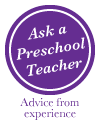 It’s that time of year: school is starting. And for a certain group of apprehensive families, school is starting for the first time ever. The first transition to preschool is a fraught, scary, weird transition, and though it’ll all be okay in the end, you want to negotiate the process with as little pain as possible—for your child AND for you.
It’s that time of year: school is starting. And for a certain group of apprehensive families, school is starting for the first time ever. The first transition to preschool is a fraught, scary, weird transition, and though it’ll all be okay in the end, you want to negotiate the process with as little pain as possible—for your child AND for you.
Making the transition easier on your child
By far the best thing you can do for your child is to have clear, consistent routines for drop-off and pick-up. Try to establish a drop-off ritual: for instance, walk around the room together saying hi to people, read one book together, give a hug, and then goodbye. If you say you’re going to leave after one book, you must leave after one book. Your child is scared about this transition already, he will be way more scared if he thinks he can’t trust what you say. If you say, “It’s time to go,” and then you stay ten more minutes, does that mean you might be lying when you say, “I’ll come back for you after lunch”? I know, if your child is crying it’s very hard to leave, but if you said you were going to, you have to—that’s how you build trust, and predictability, and stability.
When you’re leaving, do your best to put on a brave face. What will make the transition easiest for your child is for them to see that you have complete trust in the school. So even if you’re holding back tears yourself (see below), give a smile and a hug and say, “I’ll see you later!” and walk out the door. If you need to pull yourself together, that’s totally okay—just do it out of view of your child. Perhaps in the lobby, where there’ll be half a dozen other parents doing the same thing 😉
If your child is feeling sad or scared, don’t try to talk them out of their feelings: “Don’t be sad, sweetie! Look, Legos!” It just doesn’t work. He’s upset for legitimate reasons, that are worthy of your respect. Better to say, “I know you’re feeling bad about school right now. I hope you feel better soon. Right now it’s time for me to go.” Likewise, trying to distract your child—getting him involved in blocks and then sneaking away—buys you one clean getaway at the price of eroding your child’s trust in you. What he’ll learn is that he shouldn’t turn their back on you even for an instant, because you might disappear—and that’ll make the next goodbye even harder.
It can help for your child to have a tangible reminder of home and family to hang onto at school. A favorite blanky or stuffed animal is good, but equally helpful is a photograph of your family that he can carry around. In particularly hard seperations, it can help to leave a personal item of yours with your child—a bracelet you wear, perhaps, or a piece of your clothing. It reminds your child of you, and can oddly reassure him: it’s as if he’s thinking, “Well, she may not come back for me, but I know she’ll come back for her sweater!”
If it’s not seeming any easier for your child after four or five days, talk to your preschool teacher. Chances are your child cries for five minutes and then is ready to play—but you don’t get to see the good stuff, you just see the tears. (When it’s my classroom and I know the transition’s been tough, I often call a parent’s cell as soon as the child calms down, just to let them know things are okay.) Also, your teacher may be able to recommend some strategies that might help your child. But no matter what, remember: dealing with this is your teacher’s job. It’s not your responsibility to drop off a happy child every morning, and you shouldn’t feel bad about leaving them with a crying child. This is our job, and we’re good at it, and we’re prepared for it, and we’ve done it a thousand times. Don’t drop your child and sprint out the door, but don’t feel bad about going when it’s time to go.
Making the transition easier for you
It’s not uncommon for the start of preschool to be more upsetting for the parent than for the child. Your baby is leaving home—of course you’re upset!
If your child is playing happily at school and you’re the one who isn’t ready to leave, you can ask your teacher if it’s okay to stay and watch from the side for awhile. Alternately, ask if you can come early before pick up time, and either to join the class or just to watch from the window.
It can help both you and your child to spend some extra quality together during the first few weeks of school. Make special opportunities to bond and do fun things together; you’ll both feel good, and it will reinforce your relationship during this stressful time.
Make sure you get some support for yourself, if you’re feeling sad; there’s no reason to go through this normal stress alone. Talk to friends, other parents, relatives—they’ll help you feel better. If all else fails, after you drop your child off, walk straight from the classroom to the preschool director’s office; it’s part of her job to support parents too!
Overall, if you’re feeling upset about the transition, from your side or you child’s, don’t worry—it’s a normal feeling, and you’re not alone. Just remember, your child is taking his emotional cues from you, so do your best to put on a calm face in front of him. But take comfort in knowing that your teacher has been through this transition with literally hundreds of families, and yours is neither the hardest nor the easiest. Whatever you’re going through, it’s a normal part of starting school, and it’s going to be okay.
* * *
Are you going through the transition to preschool? How’s it going? Or if you’ve gone through it in the past, what made it easier? Share your experiences in the comments section.




